Determination of Isoflavones in Radix puerariae from Different Origins by Ultra-High Performance Liquid Chromatography Based on Optimal Pretreatment Method
Abstract
1. Introduction
2. Materials and Methods
2.1. Chemicals and Reagents
2.2. Sample Pretreatment
2.3. UPLC Condition
2.4. Statistical Analysis
3. Results and Discussion
3.1. Optimization of Chromatographic Conditions
3.2. Optimization of Extraction Conditions
3.3. Optimization of Purification Conditions
3.4. Linearity, Limits of Detection and Quantification
3.5. Recovery and Precision
3.6. Determination of the Sample
4. Conclusions
Author Contributions
Funding
Institutional Review Board Statement
Informed Consent Statement
Data Availability Statement
Conflicts of Interest
References
- Zhang, S.; Wang, J.; Zhao, H.; Luo, Y. Effects of three flavonoids from an ancient traditional Chinese medicine Radix puerariae on geriatric diseases. Brain Circ. 2018, 4, 174. [Google Scholar] [PubMed]
- Liu, J.; Zhang, J.; Liao, T.; Zhou, L.; Zou, L.; Liu, Y.; Zhang, L.; Liu, W. Thermal inactivation kinetics of kudzu (Puerariae lobata) polyphenol oxidase and the influence of food constituents. Foods 2021, 10, 1320. [Google Scholar] [CrossRef] [PubMed]
- Wang, D.; Qiu, L.; Wu, X.; Wei, H.; Xu, F. Evaluation of kudzu root extract-induced hepatotoxicity. J. Ethnopharmacol. 2015, 176, 321–326. [Google Scholar] [CrossRef]
- Zhu, Y.; Wang, B.; Ma, M. Pathogenesis of acute hemolysis and renal failure induced by puerarin. Chin. J. New Med. Clin. Med. 2003, 22, 699–702. [Google Scholar]
- Guan, L.; Chen, Z. Possible developmental and reproductive toxicity of isoflavones in soybean and Kudzu root. Asia Pac. J. Clin. Nutr. 2005, 14, S105. [Google Scholar]
- Yang, L.; Yang, C.; Li, C.; Zhao, Q.; Liu, L.; Fang, X.; Chen, X.-Y. Recent advances in biosynthesis of bioactive compounds in traditional Chinese medicinal plants. Sci. Bull. 2016, 61, 3–17. [Google Scholar] [CrossRef] [PubMed]
- Duru, K.C.; Mukhlynina, E.A.; Moroz, G.A.; Gette, I.F.; Danilova, I.G.; Kovaleva, E.G. Anti-diabetic effect of isoflavone rich kudzu root extract in experimentally induced diabetic rats. J. Funct. Foods 2020, 68, 103922. [Google Scholar] [CrossRef]
- Niu, Y.; Li, H.; Dong, J.; Wang, H.; Hashi, Y.; Chen, S. Identification of isoflavonoids in Radix puerariae for quality control using on-line high performance liquid chromatography-diode array detector-electrospray ionization-mass spectrometry coupled with post-column derivatization. Food Res. Int. 2012, 48, 528–537. [Google Scholar] [CrossRef]
- Chen, T.R.; Chen, L.A.; Wei, Q.K. Evaluation of quality of Radix puerariae herbal medicine by isoflavonoids. J. Pharm. Pharmacol. 2010, 62, 644–650. [Google Scholar] [CrossRef]
- Boué, S.M.; Wiese, T.E.; Nehls, S.; Burow, M.E.; Elliott, S.; Carter-Wientjes, C.H.; Shih, B.Y.; McLachlan, J.A.; Cleveland, T.E. Evaluation of the estrogenic effects of legume extracts containing phytoestrogens. J. Agric. Food Chem. 2003, 51, 2193–2199. [Google Scholar] [CrossRef]
- Chen, L.; Jiang, E.; Guan, Y.; Xu, P.; Shen, Q.; Liu, Z.; Zhu, W.; Chen, L.; Liu, H.; Dong, H. Safety of high-dose Puerariae Lobatae Radix in adolescent rats based on metabolomics. Food Sci. Nutr. 2021, 9, 794–810. [Google Scholar] [CrossRef] [PubMed]
- Du, G.; Zhao, H.; Zhang, Q.; Li, G.-H.; Yang, F.; Wang, Y.; Li, Y.; Wang, Y. A rapid method for simultaneous determination of 14 phenolic compounds in Radix puerariae using microwave-assisted extraction and ultra high performance liquid chromatography coupled with diode array detection and time-of-flight mass spectrometry. J. Chromatogr. A 2010, 1217, 705–714. [Google Scholar] [CrossRef] [PubMed]
- Du, G.; Zhao, H.; Song, Y.; Zhang, Q.; Wang, Y. Rapid simultaneous determination of isoflavones in Radix puerariae using high-performance liquid chromatography–triple quadrupole mass spectrometry with novel shell-type column. J. Sep. Sci. 2011, 34, 2576–2585. [Google Scholar] [CrossRef] [PubMed]
- Zhang, Y.; Chen, J.; Zhang, C.; Wu, W.; Liang, X. Analysis of the estrogenic components in kudzu root by bioassay and high performance liquid chromatography. J. Steroid Biochem. Mol. Biol. 2005, 94, 375–381. [Google Scholar] [CrossRef]
- Wu, W.; Zhang, Y.; Zhang, F.; Liu, J.; Ren, Z.; Xu, Y.; Liu, T.; Zhou, W.; Li, H.; Zhang, C. An analytical strategy for accurate, rapid and sensitive quantitative analysis of isoflavones in traditional Chinese medicines using ultra-high performance supercritical fluid chromatography: Take Radix puerariae as an example. J. Chromatogr. A 2019, 1606, 460385. [Google Scholar] [CrossRef]
- Fan, J.-P.; Mao, D.-Y.; Zhang, X.-H.; Qi, G.-X.; Liao, D.-D.; Chen, H.-P.; Huang, K. Preparation and characterization of a novel freestanding flexible reduced graphene oxide composite membrane for adsorption of isoflavone in Radix puerariae Lobatae. Colloids Surf. A Physicochem. Eng. Asp. 2020, 599, 124911. [Google Scholar] [CrossRef]
- Fan, J.-P.; Cheng, Y.-T.; Zhang, X.-H.; Xiao, Z.-P.; Liao, D.-D.; Chen, H.-P.; Huang, K.; Peng, H.-L. Preparation of a novel mixed non-covalent and semi-covalent molecularly imprinted membrane with hierarchical pores for separation of genistein in Radix puerariae Lobatae. React. Funct. Polym. 2020, 146, 104439. [Google Scholar] [CrossRef]
- Yu, X.; Gao, Y.; Xu, Y.; Guo, X.; Guo, L.; Tan, T.; Liu, F.; Wan, Y. Study of the contents of analogues of aristolochic acid in Houttuynia cordata by ultra-high performance liquid chromatography tandem mass spectrometry. Foods 2022, 11, 302. [Google Scholar] [CrossRef]
- Peng, Z.; Li, Q.; Zhang, G.; Zhao, W.; Lian, H.; Zhang, S. Solid phase extraction and high performance liquid chromatography with tetraaza [2] arene [2] triazine-bonded silica gel adsorbent for determination of nitrophenols and diethylstilbestrol in river water. Chin. J. Chromatogr. 2020, 38, 143–148. [Google Scholar]
- Tuzimski, T.; Szubartowski, S. Method development for selected bisphenols analysis in sweetened condensed milk from a can and breast milk samples by HPLC–DAD and HPLC-QqQ-MS: Comparison of sorbents (Z-SEP, Z-SEP Plus, PSA, C18, Chitin and EMR-Lipid) for clean-up of QuEChERS extract. Molecules 2019, 24, 2093. [Google Scholar] [CrossRef]
- Kirschner, N.; Dias, A.N.; Budziak, D.; da Silveira, C.B.; Merib, J.; Carasek, E. Novel approach to high-throughput determination of endocrine disruptors using recycled diatomaceous earth as a green sorbent phase for thin-film solid-phase microextraction combined with 96-well plate system. Anal. Chim. Acta 2017, 996, 29–37. [Google Scholar] [CrossRef] [PubMed]
- Gao, Y.; Xu, M.; Zheng, Z.; Wan, Y.; Wu, S.; Li, C. Preparation of ZIF-8 and Its Application in Determination of Pyridoxine and Pyridoxal in Ginkgo Seeds by Ultra-Performance Liquid Chromatography. Foods 2022, 11, 2014. [Google Scholar] [CrossRef] [PubMed]
- Qu, L.; Song, K.; Zhang, Q.; Guo, J.; Huang, J. Simultaneous determination of six isoflavones from puerariae lobatae radix by cpe-hplc and effect of puerarin on tyrosinase activity. Molecules 2020, 25, 344. [Google Scholar] [CrossRef] [PubMed]
- Zeng, A.; Xing, J.; Wang, C.; Song, J.; Li, C.; Yang, X.; Yang, G. Simultaneous analysis and retention behavior of major isoflavonoids in Radix puerariae lobatae and Radix puerariae thomsonii by high performance liquid chromatography with cyclodextrins as a mobile phase modifier. Anal. Chim. Acta 2012, 712, 145–151. [Google Scholar] [CrossRef]
- Wu, Y.; Wang, X.; Fan, E. Optimisation of ultrasound-assisted extraction of puerarin and total isoflavones from Puerariae Lobatae Radix (Puerariae lobata (Wild.) Ohwi) with response surface methodology. Phytochem. Anal. 2012, 23, 513–519. [Google Scholar] [CrossRef]
- He, J.; Zhao, Z.; Shi, Z.; Zhao, M.; Li, Y.; Chang, W. Analysis of isoflavone daidzein in Puerariae radix with micelle-mediated extraction and preconcentration. J. Agric. Food Chem. 2005, 53, 518–523. [Google Scholar] [CrossRef]
- Lin, F.; Giusti, M.M. Effects of solvent polarity and acidity on the extraction efficiency of isoflavones from soybeans (Glycine max). J. Agric. Food Chem. 2005, 53, 3795–3800. [Google Scholar] [CrossRef]
- Lee, M.-H.; Lin, C.-C. Comparison of techniques for extraction of isoflavones from the root of Radix puerariae: Ultrasonic and pressurized solvent extractions. Food Chem. 2007, 105, 223–228. [Google Scholar] [CrossRef]
- Surma, M.; Sadowska-Rociek, A.; Cieślik, E. Application of quechers method for the determination of phenylurea herbicides in beetroot by hplc with uv-vis detection. J. Microbiol. Biotechnol. Food Sci. 2021, 2021, 145–147. [Google Scholar] [CrossRef]
- Wu, X.; Ding, Z. Evaluation of matrix effects for pesticide residue analysis by QuEChERs coupled with UHPLC-MS/MS in complex herbal matrix. Food Chem. 2022, 405, 134755. [Google Scholar] [CrossRef]
- Chen, S.-B.; Liu, H.-P.; Tian, R.-T.; Yang, D.-J.; Chen, S.-L.; Xu, H.-X.; Chan, A.S.; Xie, P.-S. High-performance thin-layer chromatographic fingerprints of isoflavonoids for distinguishing between Radix puerariae Lobate and Radix puerariae Thomsonii. J. Chromatogr. A 2006, 1121, 114–119. [Google Scholar] [CrossRef] [PubMed]
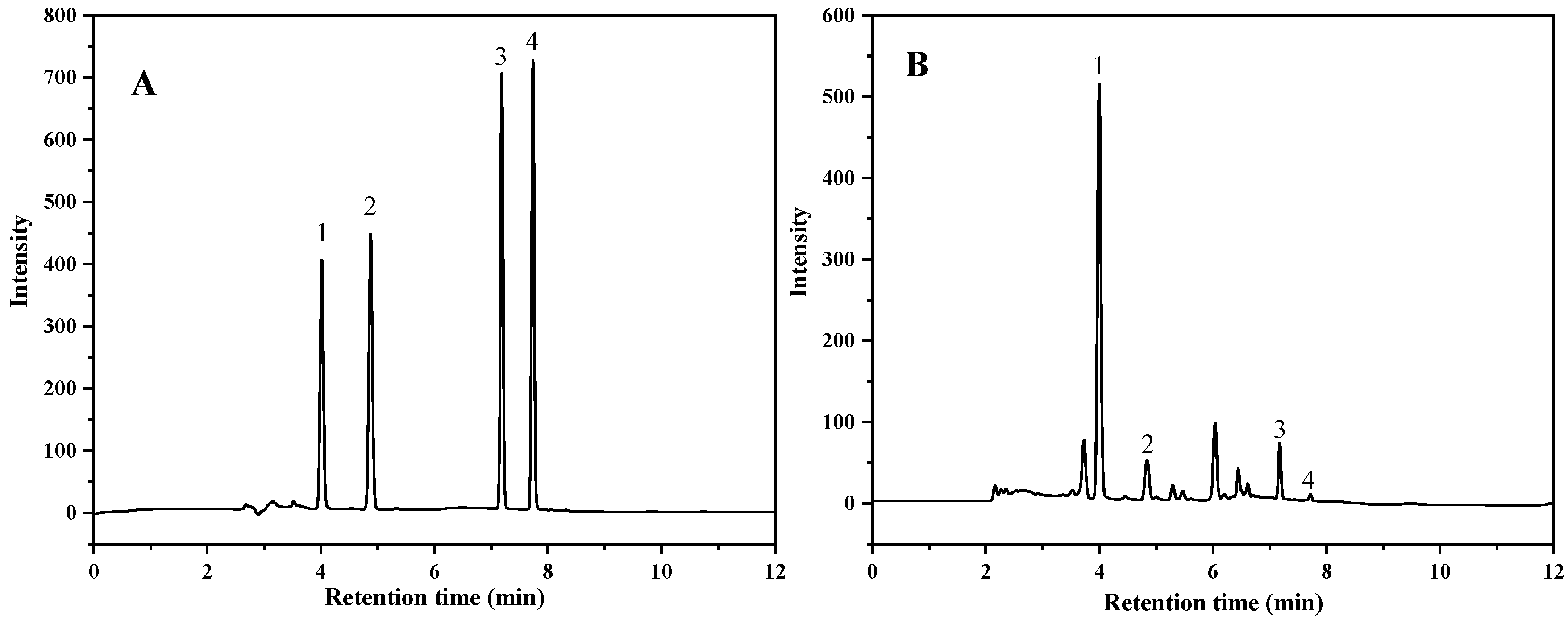
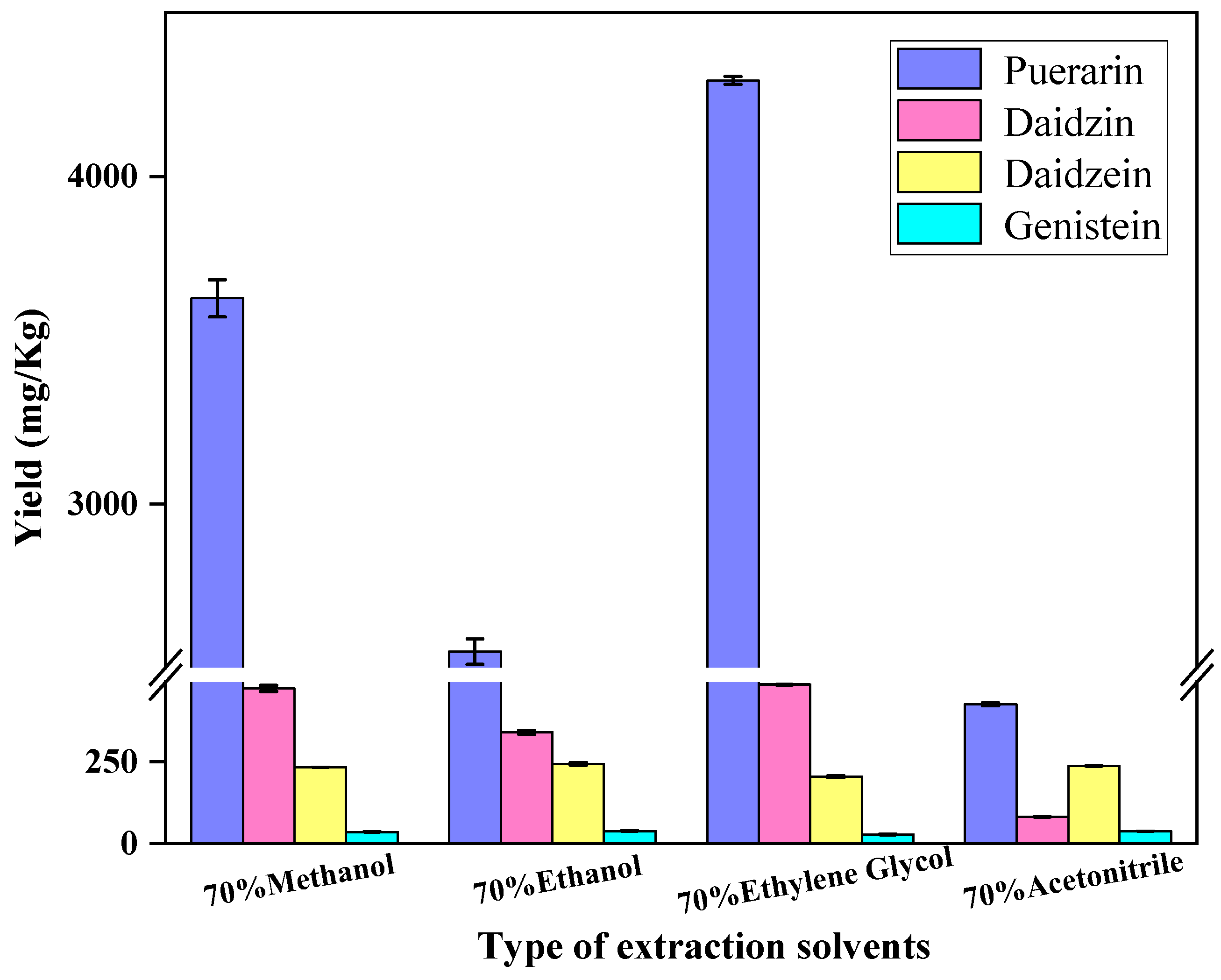
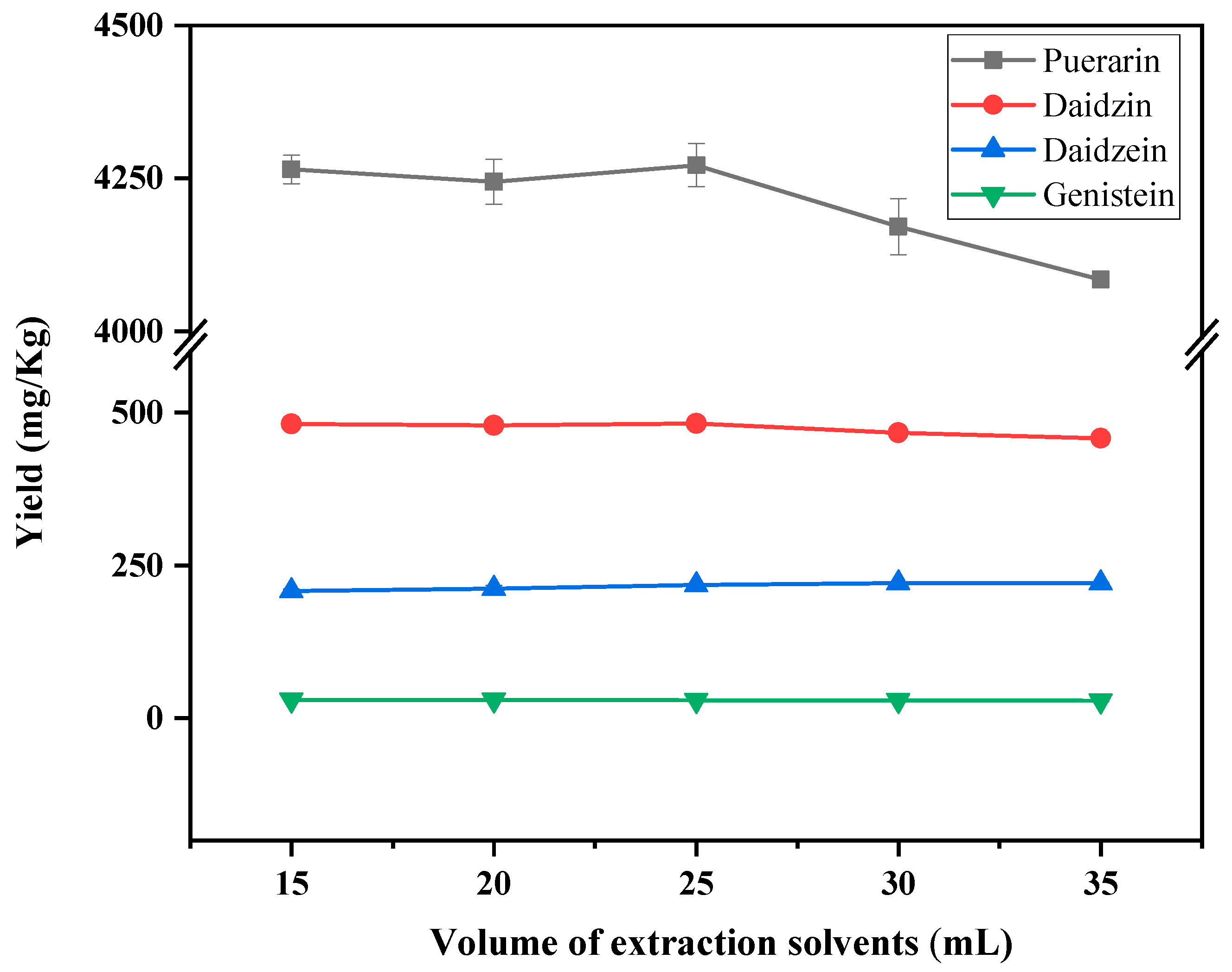
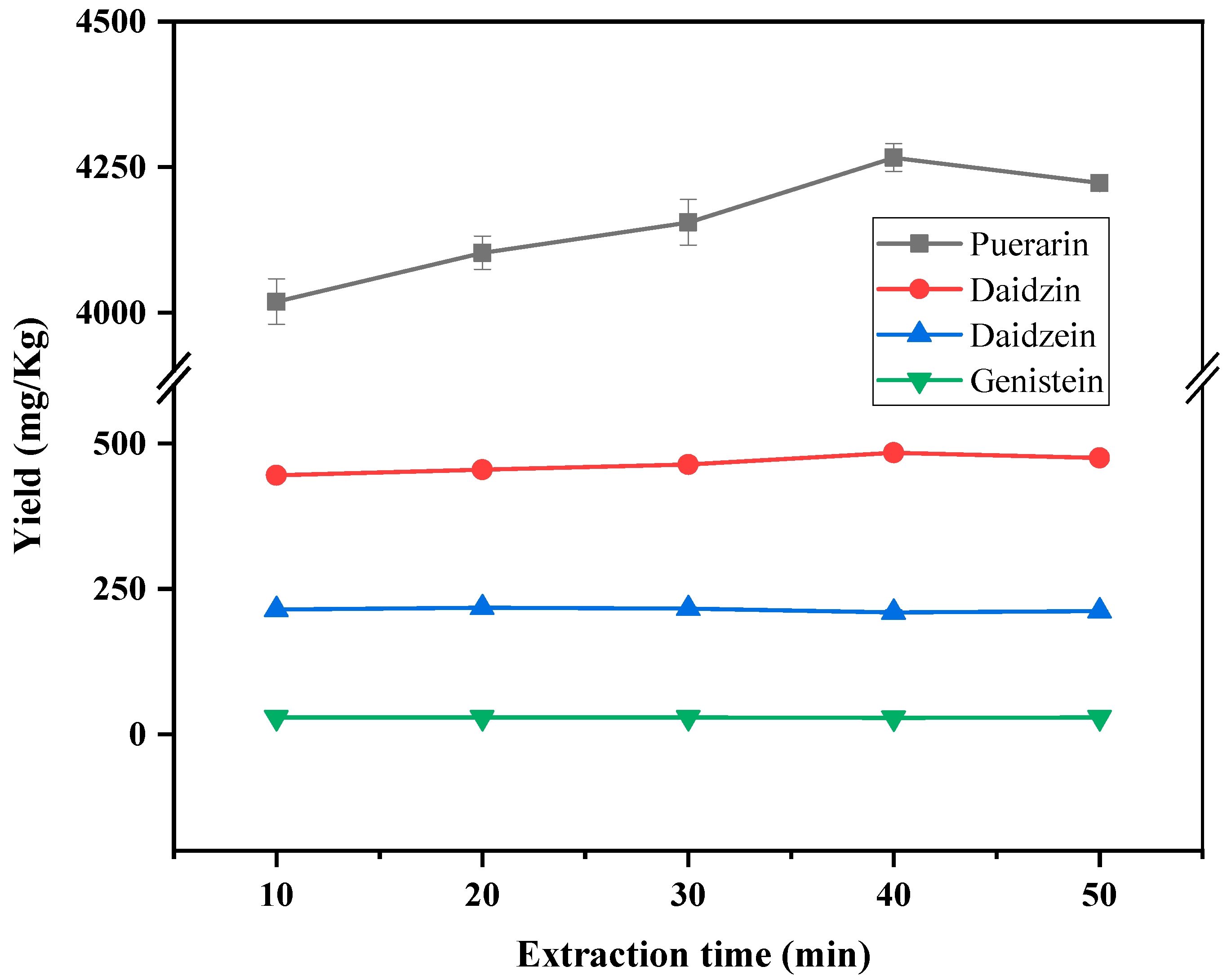

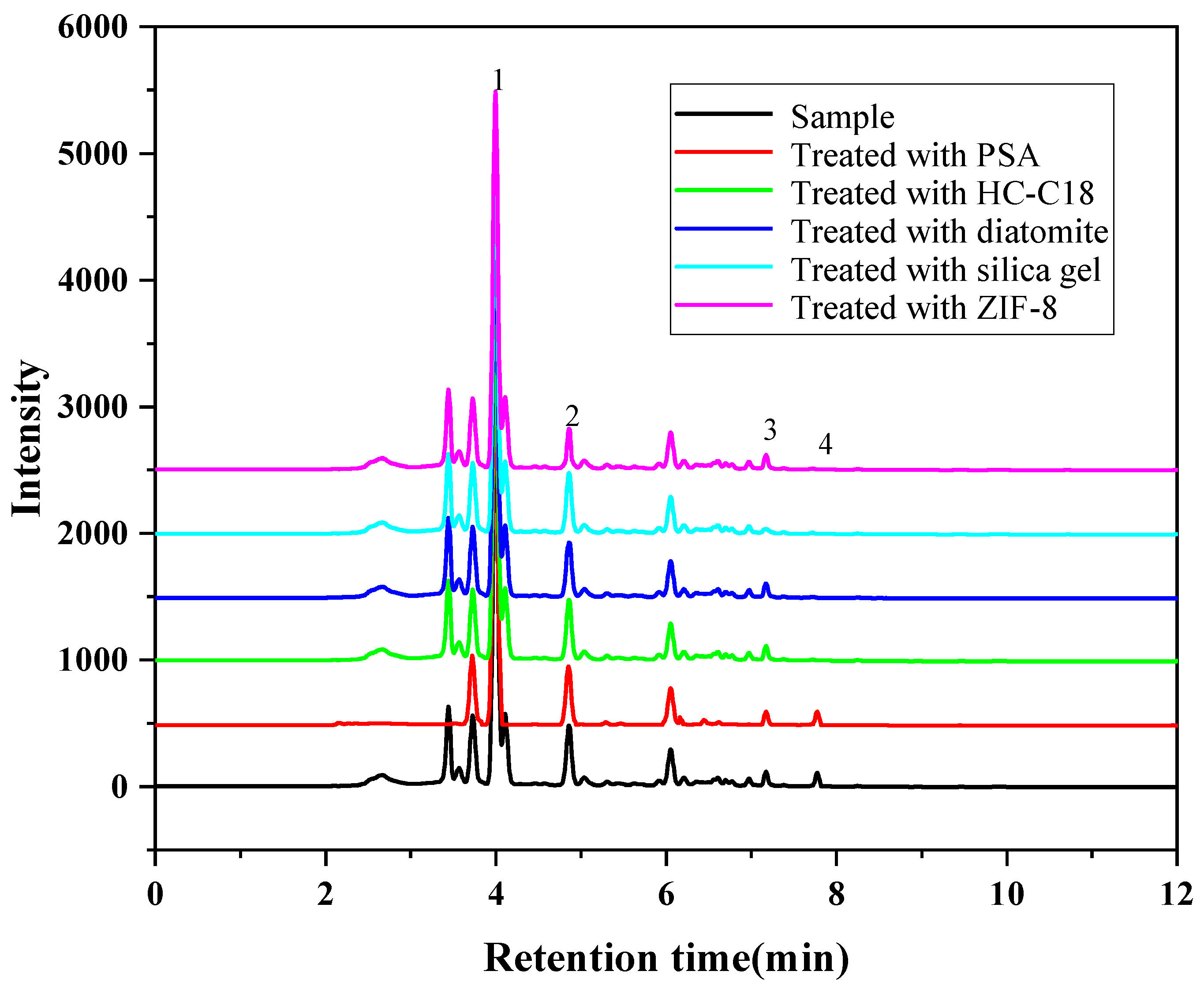
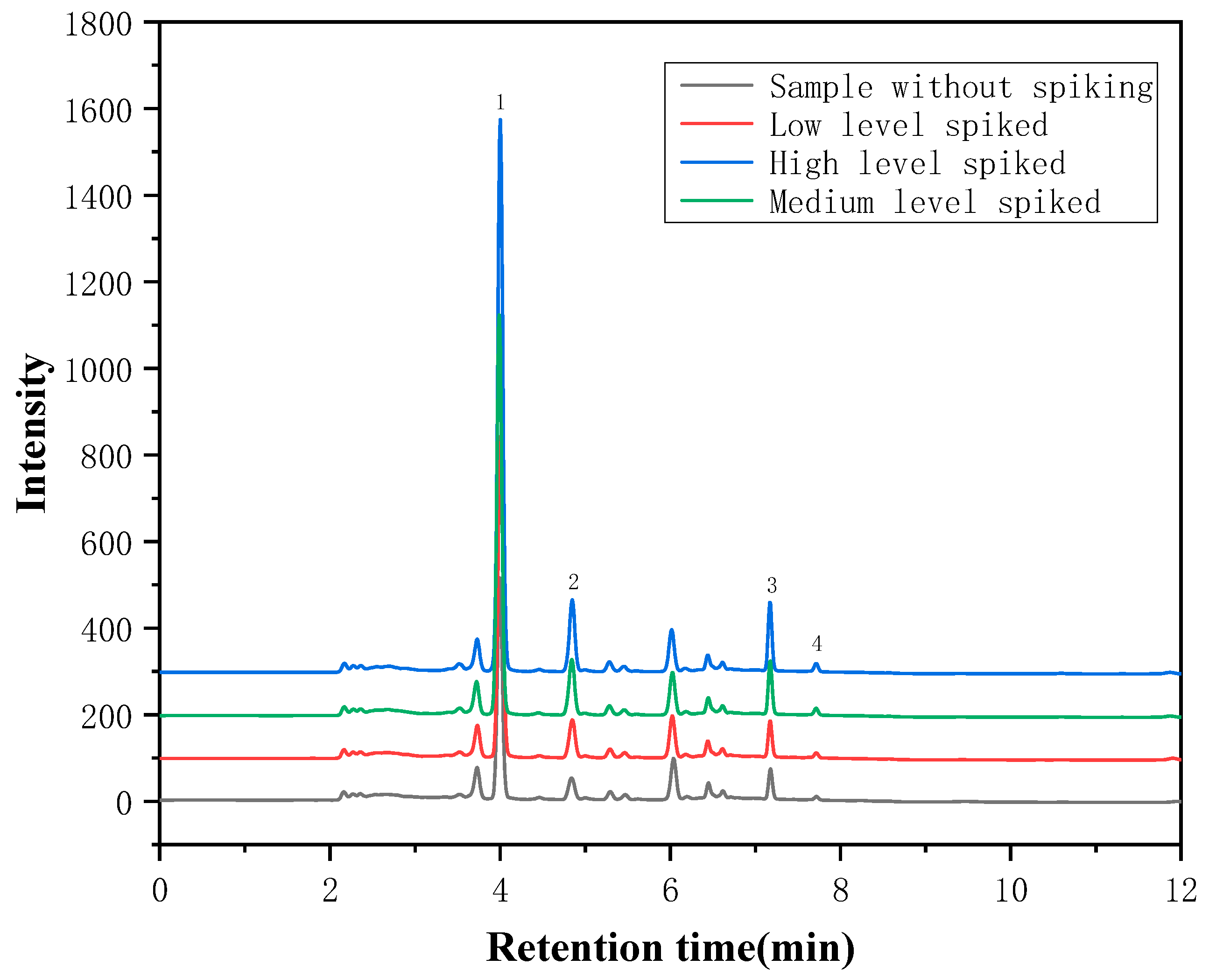
| Time (min) | A (%) | B (%) |
|---|---|---|
| 0 | 80 | 20 |
| 3 | 70 | 30 |
| 6 | 20 | 80 |
| 10 | 20 | 80 |
| 10.1 | 80 | 20 |
| Compounds | Linear Range (mg/L) | Calibration Curves | R2 | LOD (mg/L) | LOQ (mg/L) |
|---|---|---|---|---|---|
| Puerarin | 2–200 | y = 25.6x − 38.6 | 0.9981 | 0.086 | 0.29 |
| Daidzin | 1–100 | y = 26.7x − 5.6 | 0.9981 | 0.020 | 0.065 |
| Daidzein | 1–100 | y = 57.0x − 22.9 | 0.9997 | 0.027 | 0.090 |
| Genistein | 0.1–10 | y = 53.8x + 3.4 | 0.9998 | 0.037 | 0.12 |
| Compounds | Background Value (mg/kg) | Spiking Level (mg/kg) | Recovery (%) | RSD (%) |
|---|---|---|---|---|
| Puerarin | 4366 | 2100 | 96.1 | 0.76 |
| 4000 | 101.3 | 1.2 | ||
| 6000 | 102.2 | 1.1 | ||
| Daidzin | 520 | 300 | 109.6 | 1.8 |
| 500 | 105.3 | 2.0 | ||
| 750 | 97.6 | 2.1 | ||
| Daidzein | 210 | 100 | 101.0 | 5.1 |
| 200 | 94.9 | 4.6 | ||
| 300 | 104.7 | 6.8 | ||
| Genistein | 25 | 14 | 102.2 | 7.7 |
| 28 | 90.7 | 6.4 | ||
| 42 | 90.5 | 6.1 |
| Origins | Variety | Contents (mg/g) | |||
|---|---|---|---|---|---|
| Puerarin | Daidzin | Daidzein | Genistein | ||
| Linyi, Shandong | RPL | 37.0 ± 0.5 * | 9.15 ± 0.19 | 1.36 ± 0.17 | 0.15 ± 0.01 |
| Shennongjia, Hubei | RPL | 15.9 ± 0.7 | 2.21 ± 0.11 | 1.18 ± 0.01 | 0.010 ± 0.001 |
| Shangluo, Shaanxi | RPL | 80.4 ± 0.7 | 12.0 ± 0.1 | 1.02 ± 0.03 | 0.087 ± 0.004 |
| Dabieshan, Anhui | RPL | 78.6 ± 0.9 | 11.4 ± 0.2 | 0.99 ± 0.03 | 0.071 ± 0.003 |
| Zhangjiajie, Hunan | RPL | 78.3 ± 0.8 | 11.1 ± 0.1 | 1.12 ± 0.02 | 0.082 ± 0.001 |
| Shangrao, Jiangxi | RPL | 55.4 ± 1.9 | 9.72 ± 0.35 | 0.88 ± 0.04 | 0.082 ± 0.005 |
| Chengdu, Sichuan | RPL | 101.9 ± 0.7 | 14.9 ± 0.1 | 0.87 ± 0.03 | 0.072 ± 0.002 |
| Bozhou, Anhui | RPT | 4.14 ± 0.20 | 0.73 ± 0.02 | 0.14 ± 0.01 | 0.019 ± 0.003 |
| Anqing, Anhui | RPT | 4.37 ± 0.02 | 0.53 ± 0.01 | 0.21 ± 0.01 | 0.026 ± 0.004 |
| Chuxiong, Yunnan | RPT | 6.33 ± 0.16 | 1.02 ± 0.03 | 0.18 ± 0.01 | 0.021 ± 0.002 |
| Wuzhou, Guangxi | RPT | 4.21 ± 0.09 | 0.88 ± 0.01 | 0.22 ± 0.02 | 0.023 ± 0.003 |
Disclaimer/Publisher’s Note: The statements, opinions and data contained in all publications are solely those of the individual author(s) and contributor(s) and not of MDPI and/or the editor(s). MDPI and/or the editor(s) disclaim responsibility for any injury to people or property resulting from any ideas, methods, instructions or products referred to in the content. |
© 2023 by the authors. Licensee MDPI, Basel, Switzerland. This article is an open access article distributed under the terms and conditions of the Creative Commons Attribution (CC BY) license (https://creativecommons.org/licenses/by/4.0/).
Share and Cite
Gao, Y.; Xu, M.; Wan, H.; Li, C.; Wan, Y. Determination of Isoflavones in Radix puerariae from Different Origins by Ultra-High Performance Liquid Chromatography Based on Optimal Pretreatment Method. Foods 2023, 12, 794. https://doi.org/10.3390/foods12040794
Gao Y, Xu M, Wan H, Li C, Wan Y. Determination of Isoflavones in Radix puerariae from Different Origins by Ultra-High Performance Liquid Chromatography Based on Optimal Pretreatment Method. Foods. 2023; 12(4):794. https://doi.org/10.3390/foods12040794
Chicago/Turabian StyleGao, Yuan, Mengjia Xu, Hao Wan, Chang Li, and Yiqun Wan. 2023. "Determination of Isoflavones in Radix puerariae from Different Origins by Ultra-High Performance Liquid Chromatography Based on Optimal Pretreatment Method" Foods 12, no. 4: 794. https://doi.org/10.3390/foods12040794
APA StyleGao, Y., Xu, M., Wan, H., Li, C., & Wan, Y. (2023). Determination of Isoflavones in Radix puerariae from Different Origins by Ultra-High Performance Liquid Chromatography Based on Optimal Pretreatment Method. Foods, 12(4), 794. https://doi.org/10.3390/foods12040794






